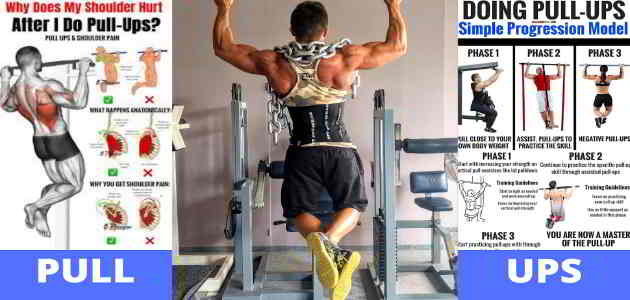12 Tips for Better Pull-Ups but Why Pull-Ups?
The pull-up is one of the simplest and most effective exercises you can do to carve up your upper body—back, arms, chest, and shoulders—as well as firm up your core. This exercise that you can perform almost anywhere ignites a complex blend of muscle groups to raise your fitness to new levels.
A simple bar hung over a closet door or a jungle gym at a ground (my favorite) can be used for a muscle-sculpting workout that takes only a few minutes, three days a week.
If you’re looking to boost your strength, muscle tone, and overall fitness, pull-ups are one of the easiest exercises to understand and complete. Pull-ups are fantastic for building strength, endurance, and, even more importantly, confidence.
Over time, athletes have learned that pull-ups are one of the quickest ways to strengthen and tone the upper body, arms, and abs.
Not only is lifting your body weight critical to building a lean, strong, and fit body, but it’s also vital for participation in athletics.
All sports require athletes to be strong yet agile enough to play at a high level and avoid injury. Thus, pull-ups are a staple exercise for any athlete.
You don’t need to fear the pull-up as I once did. It’s actually a lot easier to do than you think, once you learn the proper technique.
This technique allows the large muscles of your back, chest, shoulders, and arms to distribute the workload.
Most people that start the 7 Weeks program tell me that they’re amazed at how much they can do when they use the proper pull-up form. Pull-ups are also an exercise that gets respect from most people in the gym.
Many people are afraid to do sets of pull-ups in front of others for fear of tiring in the middle of a set. But once you’re able to complete sets of pull-ups, the other gym rats will look at you differently.
I’ve actually had other gym patrons come up to me after a set—some of whom can out-bench me by a hundred pounds or more—and say, “I wish I could do that many!”.
Once when I completed a set at a gym, an older woman who was working with a trainer pointed at me and said, “I want to keep working out so I can do that!” An online friend once sent me the following message:
“Do you know why I am doing the 7 Weeks to 50 Pull-Ups program? So one day soon I can knock out a set of 25 at the gym and yell Boo-yah! in front of all the meatheads.”
Take The 35 Straight Pull-Ups Challenge:
Compound movements like pull-ups should be a big part of any exercise routine since most activities that we perform every day—everything from starting a lawnmower to simply getting out of bed — typically consist of compound movements.
The pull-up will also assist in maintaining a proper range of motion throughout the upper body. In addition, stressing the upper body muscles can help you avoid injury by increasing bone density, building lean muscle, and strengthening the many stabilizing muscles, ligaments, and tendons within the shoulder.
Whether you’re a soldier, an athlete, or just someone looking to get leaner, stronger, and more ripped, pull-ups are the single best exercise you can do to attain your fitness goals.
Pull Up Challenge | Can You Beat It?
12 Tips for Better Pull-Ups
Here are the top 12 tips for pull-ups, if you are a beginner at pull up these tips are really helpful for you.1) TELL YOUR FRIENDS
2) ASK A FRIEND TO JOIN YOU
It’ll make the workouts harder to skip and you’ll push each other to complete your goals.3) DON’T STRESS ABOUT THE NUMBER OF PULL-UPS YOU CAN DO WHEN YOU BEGIN
It might be zero, it might be twenty. But by the time you finish the program, you’ll be able to do far more than you could do at the start.
4) DON’T OVERDO IT
5) TAKE IT EASY AND USE GOOD FORM
6) DO IT AT YOUR OWN PACE
7) HAVE FUN
8) REWARD YOURSELF FOR SUCCESSES
9) PULL-UPS ARE HARD
10) DON’T. GET. DISCOURAGED
11) BREATHE
Sounds easy, right? Well, you would be amazed (okay, maybe you wouldn’t) at how often people hold their breath when exercising.
You can’t exercise if you don’t breathe—period. Breathe out as you pull up, breathe in as you lower yourself. Easy, right?
When you find yourself lightheaded after a set, you’ll remember that you didn’t breathe properly.
12) START AT HOME
It’s very intimidating to hop on a pull-up bar at a gym and work on a set. I do pull-ups three to four days a week and I still sometimes feel uneasy.
Pick up an inexpensive pull-up bar that you can hang in a doorway and practice at home until you’re comfortable.
Whether you use a chair or band for assistance, you can focus on the workout instead of worrying about whether or not people are looking at you.
The biggest benefit of having your own pull-up bar at home is fitting the workout into your routine. I work out at lunch each day (the secret to loving your job!),
but if I have a lunchtime meeting scheduled, I’ll do a set in the morning somewhere in between getting ready, coffee, breakfast, or morning e-mail.
The “over door” pull-up bars are great because you don’t need to mount them, and they only take a couple seconds to put up and take down. I’m also really fond of the multiple hand positions.






3 Comments
I wanted to thank you for this great read. I definitely enjoying every little bit of it I have you bookmarked to check out new stuff you post.
ReplyDeletefitbit charge 3 setup
Thank You.
DeleteMost women’s wants their breast lift, firm and perk up. For perking chest what they do? They go through surgeries, treatments, medications, massages, therapies and benefits of chest exercises for females other stuff. But end up with drawbacks and temporary or permanent loss of sensation in the breast etc.
ReplyDeletePlease Do Not Spam